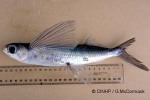Cook Islands Biodiversity Database
Species Page
Cheilopogon spilonotopterus
MāroroWhitemargin Flyingfish*
Multimedia & Additional Resources
| Type | Description | Download |
| Adult - dead; posterior and fin detail | 57KB |
General Information
Cook Islands Distribution
| Southern Group: Present Makatea: | ||||||||
RR |
MG |
AT |
MK |
MT |
AK |
PL |
TK |
MN |
++++ |
^P |
|||||||
| Northern Group: | |||||
TN |
MH |
RK |
PK |
NS |
SW |
P |
P |
||||
Scientific Taxonomy
Cheilopogon spilonotopterus (Bleeker, 1866)
SYNONYMS: Cypselurus spilonotopterus; Exocoetus spilonotopterus [O]; Cypselurus tahitensis
TAXONOMY: ANIMALIA; CHORDATA; GNATHOSTOMATA (Jawed Vertebrates); PISCES; OSTEICHTHYES; Beloniformes; Belonoidei; Exocoetoidea; EXOCOETIDAE
More Information
SIGNIFICANCE NOTES -
POSITIVE SIGNIFICANCE: Food. Comments: Flyingfishes are a favourite food and are commonly seen for-sale on the side of the road on Rarotonga, especially from August to February, the main spawning season -CHECK CHECK. They are also the main fresh baits used in trolling for tunas and wahoo. They are also used as bait for the deep drop-line Caster-oil Fish fishery.
They are caught at night by scooping them out of the water with a dipnet/scoopnet while attracting them with a bright light, especially on moonless nights or when the moon is below the horizon. Scooping 20 fish an hour is considered "good fishing". Estimates indicate that more than 50 tonnes-a-year were caught during the 1980s throughout the Cook Islands.
GENERAL NOTE: There are five species of flyingfishes presently recorded in the Cook Islands. Their remarkable aerial gliding ability comes from their enlarged pectoral and ventral fins and a long ventral blade on the tail fin which creates thrust in the water when the fish is above the surface. They glide to escape large predatory fish, such as tunas, while they themselves feed on large zooplankton and small fish. In general they are mature at 12 months and live a total of about 24 months. They spawn may spawn three or four times a year, mainly from between August and November Most species release 15,000 to 25,000 eggs each spawning. Many flyingfishes are killed by predators and many die after spawning.
Vouchers & References
Vouchers:
Rarotonga: specimens, 7/97 Joe Heather, ID GM. Atiu: field-specimen, College collection, 10/2000, ID GMcC. Manihiki: 1 specimen #A685 (B&M74), confirmed Parin (Sims88). Pukapuka: 6 fieldspecimens+photo, 1/2004, Marurai Marurai, ID GMcC as Cheilopogon spilonotopterusQQ pectorals uniformily red-brown with narrow white margin, dorsal with large black blotch.
References:
None recorded.
Data Update History (information):
zTX, zB02, zM02, zD02
Web Resources
Citation Information
McCormack, Gerald (2007) Cook Islands Biodiversity Database, Version 2007.2. Cook Islands Natural Heritage Trust, Rarotonga. Online at http://cookislands.bishopmuseum.org. ![]()
Please refer to our use policy.

